Inheritance is a critical concept in object-oriented programming that allows code reuse and extensibility. This is crucial for writing advanced smart contracts in Solidity that are modular, efficient, and upgradable.
This comprehensive guide will explain inheritance in detail—how derived contracts can access functionality from base contracts using the is keyword. We'll cover essential aspects like types, benefits and mode of inheritance in Solidity.
Whether you're new to Solidity or have used inheritance minimally, this guide will provide examples and best practices for this powerful technique to develop complex yet flexible smart contracts.
What is Inheritance in Solidity?
Inheritance allows Solidity contracts to access functionality from other contracts called base or parent contracts. This promotes code reusability and organization. For example, contract B is said to inherit or derive from contract A when B gains access to A's methods and state variables.
The derived contract B can also override functions it inherits, providing its own implementations. We declare inheritance in Solidity with the "is" keyword - "contract B is A."
A typical real-world case is ERC token contracts inherited from the OpenZeppelin ERC20 implementation contract. This allows custom ERC20 tokens to reuse well-tested code for transfer logic, balance mapping, etc.
Functions like "transfer" and mappings like "_balances" are directly accessible in the new contract. Additional features can also be added. Inheritance structures complex logic into meaningful building blocks, cuts redundancy, and streamlines customizations. When planned effectively, it enables elegant, smart contract capabilities not otherwise feasible for developers to create independently.
How does inheritance in Solidity work?
Inheritance is a Solidity best practice that enables smart contract design patterns for efficient development. It works by allowing developer-created contracts to access the variables and functions of other "parent" contracts using the "is" keyword.
For example, contract Token is ERC20 {} allows Token to inherit from the standard ERC20 implementation. This Solidity inheritance approach cuts duplication since basic functionality like transfer() and balance mapping can be directly reused without rewriting code.
Developers can also override parent functions to customize logic while retaining inheritance relationships - a significant advantage over abstraction. For example, an OverridenTransferToken overriding transfer() may add additional validation logic before calling super. transfer().
Constructors particularly demonstrate Solidity inheritance for developers. A child contract's constructor must call super before accessing inherited state variables. Failing to call super when inheriting can produce bugs.
When planned effectively, inheritance structures complex smart contract logic into intuitive building blocks. It facilitates code clarity, grants child contracts more capabilities, and enables elegant payable functions or security checks not otherwise feasible for developers to recreate independently.
Types of Inheritance in Solidity
1. Single Inheritance
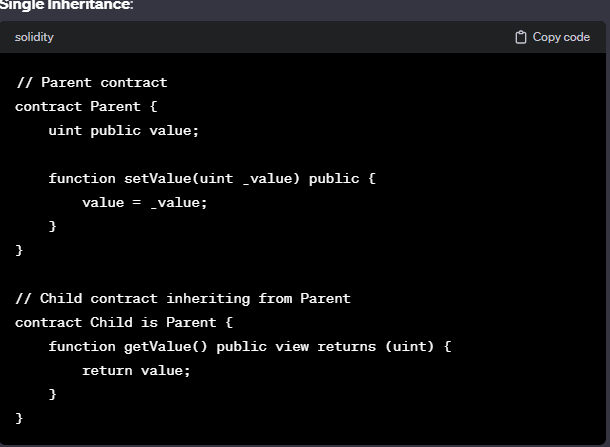
Explanation: In this example, the Child contract inherits from the Parent contract using single inheritance. The Child contract can access the value variable and the setValue function defined in the Parent contract, demonstrating the basic concept of single inheritance.
Single inheritance is when a Solidity smart contract inherits variables and functions from only one parent contract. The child contract accesses the complete set of public and internal members inherited from the parent.
For example, a bank contract can inherit from an account contract to reuse code related to account balances, withdrawals, and deposits rather than write them again. Single inheritance reduces code duplication through reuse and reflects basic object-oriented programming principles.
It creates a clean hierarchical relationship between parent and child. Contracts higher up in the hierarchy can provide broad, general capabilities, while contracts lower down can represent more specialized cases.
Design tradeoffs with single inheritance may include tightly coupling contracts together and less flexibility compared to multiple inheritance. But for many use cases, single inheritance provides powerful code reuse while minimizing complexity for readable and manageable contracts.
2. Multiple Inheritance
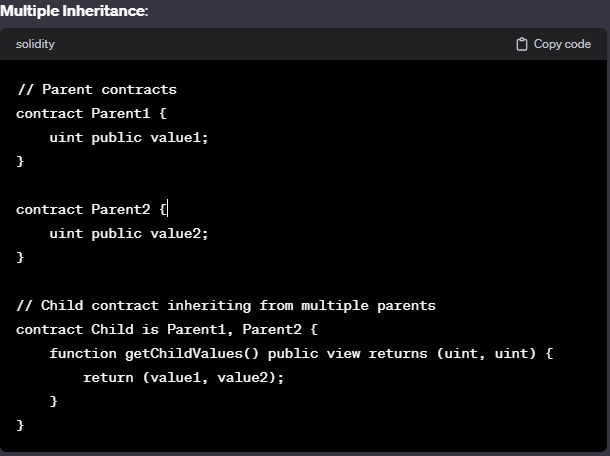
Explanation: In this example, the Child contract inherits from both Parent1 and Parent2 contracts using multiple inheritance. The Child contract can access the value1 variable from Parent1 and the value2 variable from Parent2, showcasing the ability to inherit from multiple parent contracts.
With multiple inheritance in Solidity, a smart contract can inherit variables and functions from several parent contracts instead of just one.
For example, a new contract could be inherited from both an Account contract and a Bank contract to gain useful functions from each. This differs from single inheritance and can provide more flexibility in structure and design.
At the same time, overuse of multiple inheritance can overly couple contracts and complicate relationships. Diamond inheritance issues can also surface where conflicts exist between inherited contract members.
Multiple inheritances require disciplined design to prevent these pitfalls. When leveraged judiciously, it enables contracts to be further broken down into areas of specific capability and then combined through inheritance only where needed.
Separating capabilities this way can aid readability and reuse. But in many cases, single inheritance may be preferable for its simplicity unless multiple inheritance improves contract software design meaningfully.
3. Multi-Level Inheritance
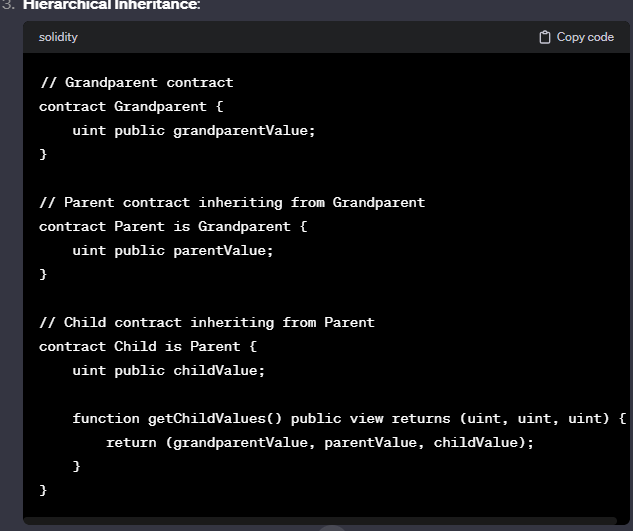
Explanation: In this example, the Child contract inherits from the Parent contract, which in turn inherits from the Grandparent contract, demonstrating hierarchical inheritance. The Child contract can access variables from all levels of the inheritance hierarchy, including grandparentValue, parentValue, and childValue.
Multi-level inheritance refers to a smart contract inheriting from another derived contract, which itself inherits from a parent. For example, ContractC could inherit from ContractB, which inherits from ContractA.
This allows both code reuse and specialization along an inheritance chain of arbitrary depth. Contract A might define foundational account functionality, Contract B customizes this with withdrawal logic, and Contract C could add further restrictions and specifications.
When well-structured, multi-level inheritance can aid readability and maintainability by separating general and specific logic. However, long inheritance chains can complicate design, overrides, and testing. Overuse of multi-level inheritance usually indicates that contracts are becoming too interdependent vs modular.
Care should be taken to restrict levels and clearly structure contract relationships. Ideal inheritance chains strike a balance - enough levels to achieve code reuse and customization goals without unmanageable coupling between contracts across multiple layers.
4. Function Overriding
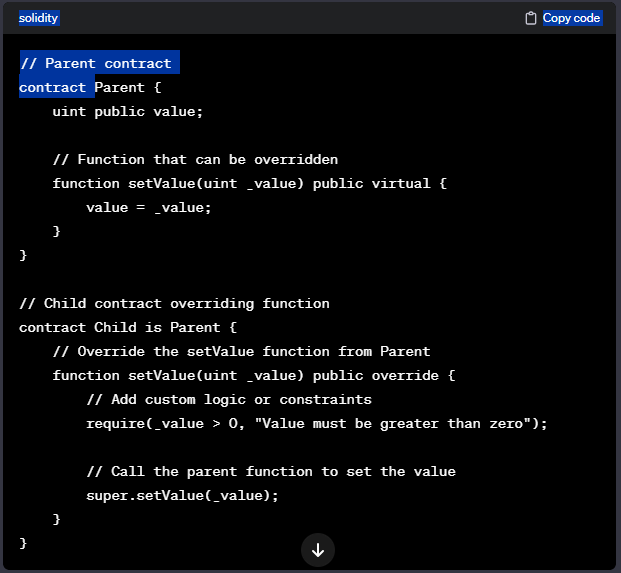
Explanation: In this example, we have a Parent contract with a function setValue that sets the value of a public variable value. The setValue function is marked as virtual, indicating that child contracts can override it.
The Child contract inherits from the Parent contract and overrides the setValue function. Inside the setValue function of the Child contract, additional logic or constraints are added using require to ensure that the value passed is greater than zero.
To invoke the parent function's behavior, the super keyword is used followed by the function name (super.setValue(_value)). This calls the setValue function of the parent contract, allowing the child contract to extend the functionality while retaining the behavior defined in the parent contract.
Function overriding means a child contract redefines a function signature inherited from a parent contract in order to replace the logic with custom code. For example, an inherited withdrawal function could be overridden to add additional withdrawal rules and restrictions.
The overriding function must match the original parameters and outputs to make the client code seamless. This mechanic enables polymorphism in Solidity where contracts high up an inheritance tree can have functions that behave differently when called by distant descendants.
Function overriding is helpful for customizing parent logic to meet specialized needs. However, overriding should be used judiciously to avoid confusion on which contract version is called.
For core functions, prefer to design explicit contract interfaces that downstream contracts must implement rather than override. Well-structured overrides can enable abstraction and modularity. But taken too far, heavy function overriding complicates analysis and testing to understand contract capabilities.
5. Abstract Contracts
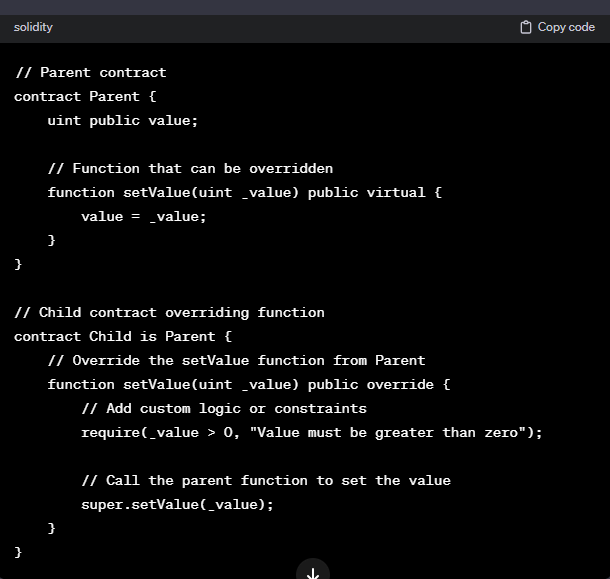
Abstract contracts are base contracts in Solidity defined with the abstract modifier, which are incomplete by themselves and designed to be inherited from. For example, an Account contract could be made abstract to provide common account functionality like deposits and withdrawals but require child contracts to define custom storage and constructors.
Abstract contracts cannot be compiled on their own; they are only inherited by non-abstract child contracts. By forcing child contracts to implement specific methods, abstract contracts enable stronger design standards.
In traditional programming, they serve as interfaces to define a contract's capabilities. Abstract inheritance is useful when you have a standard set of functions you want customized implementations of across child contracts without dictating details.
This prevents duplication yet maintains flexibility. It also aids analysis by telling readers that contract behavior differs across implementations.
Abstract inheritance enables polymorphism through well-defined contract templates tailored by child contracts. Like other inheritance patterns, judicious use balancing reuse and customization helps manage complexity.
Key Benefits of Inheritance in Solidity
1. Code Reuse
The primary benefit of inheritance in Solidity is the ability to reuse code from parent contracts. Child contracts inherit the full set of public and internal functions and state variables defined in parent contracts.
This allows core logic related to functionality like transfers, withdrawals, balances, etc., to be written once in a base contract and reused without needing to rewrite it. Inheritance enables smarter contract development by not reinventing the wheel.
2. Reduced Code Duplication
By enabling code reuse across contracts through inheritance, Solidity inherently minimizes code duplication. Common logic only needs to be written once rather than copied across multiple contracts.
For example, complex logic around deposit processing can be written in a base contract and easily reused by other contracts via inheritance without duplicate copies. This saves substantial development time, reduces potential bugs, and improves maintainability by keeping contracts DRY (Don't Repeat Yourself).
3. Modularity
Effective inheritance patterns allow smart contracts to be broken into smaller modular pieces with specific capabilities rather than cramming all logic into one larger contract. These contract modules can then be composed together through inheritance only where needed.
For instance, base contracts for transfers, withdrawals, and balances can be created separately and combined for a new bank contract. This modularity aids readability and allows simpler testing of isolated contract behavior.
Modules can also be reused across unrelated contracts that need common functions, like transfers. Appropriate modular design requires balancing cohesion and coupling to achieve the required contract capabilities while maintaining independence.
4. Polymorphism
Inheritance coupled with function overriding allows polymorphic capabilities. In this case, inherited functions can have different implementations across child contracts depending on custom logic while maintaining a common interface. This powerful technique reduces coding effort and enables customizable contract behavior rather than rigid single deployments.
Conclusion
In summary, leveraging inheritance appropriately in Solidity enables smarter contract development and maintenance. By reusing code, reducing duplication, enabling modularization, and allowing polymorphism, inheritance facilitates DRY, readable, and upgradeable contracts. It unlocks essential pillars of object-oriented programming within the domain of composable smart contracts. However, overly relying on multi-level inheritance can produce complicated tangles. The art is finding the right balance of inheritance chains to achieve component reuse without unmanageable coupling. When applied judiciously, reflecting on principles like high cohesion and loose coupling, inheritance elevates solidity to construct modular contract systems robustly and with longevity.